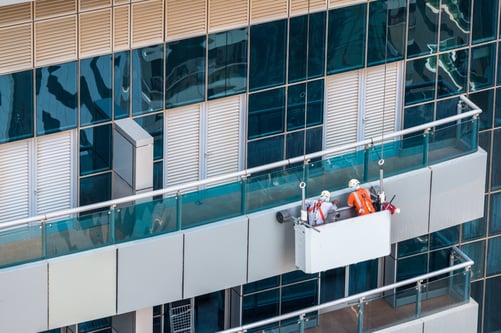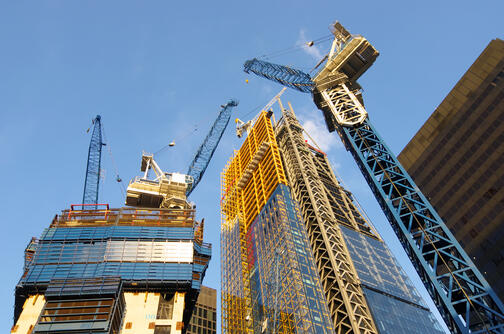Local Law 11 (LL11)
Aim for pedestrian safety by placing public protection measures such as scaffolding during the periodic facade inspections.
Get your building facade up-to-date with Local Law 11 to mitigate structural risks, hazards and liabilities.
Utilize the expertise and experience of New York Engineers for fast and accurate filing of reports with DOB.
Being the concrete urban jungle that it is, New York City has become home to some of the world’s greatest skyscrapers. Towering, boxy forms of medium-rise to high-rise buildings sprout everywhere, complementing the backdrop of the traditional architectural styles such as Beaux Arts and Art Deco. However, when there’s an upside, there’s also a downside in the form of unsafe facades. This is how Local Law 11 was born.
Almost every condominium resident, facility manager and property owner who live in buildings taller than six stories know Local Law 11 by heart. For starters, Local Law 11 imposes building facades with more than six stories to be inspected every five years by a qualified licensed architect or engineer. The basic premise of Local Law 11 is rooted in implementing safety for pedestrian and adjacent structures. As proactive as a city can get, New York City pushed immediately for the Local Law 11 sign-off after tragedies struck innocent bystanders from falling façade components. Technically, Local Law 11 is Façade Inspection Safety Program (FISP), but for simplicity’s sake, we will still use the former term.
Façades can range in all types of construction materials—name masonry, brick, stone, structural glass and all other materials that can serve as exterior walls of your building envelope. As expert engineers who work collaboratively with architects, each construction material has its own technical specification, rating, grade and all other criteria for design compliance. This leads us to one conclusion: each material calls for a specific technical evaluation process from a specialized professional. New York Engineers deliver curated solutions for every façade material inspected, bringing the trifecta of beauty, function and structural integrity in one holistic approach.
Understanding Local Law 11 means you need to trace back its roots to history. Before Local Law 11, there’s Local Law 10. In a way, you could say that Local Law 11 is a stricter and more stringent version of Local Law 10, but both laws cover one thing: tragedy prompted the making and passage of these façade safety bills.
In May of 1979, a piece of terracotta fell off from the 8th floor of a specific building on West 115th Street, killing a Barnard college student. Serving as a wake-up call and a starting point for building façade safety, then-Mayor Ed Koch immediately signed off Local Law 10 in just less than a year. Much like today’s Local Law 11, New York City still obliged taller-than-six building storeys to façade inspection but was more lax in its implementation given that only the street-facing façade was examined, until a series of unfortunate events happened again on December 1997.
After three months when the incidents happened, this served another catalyst for change since former Mayor Rudolph Giuliani pushed for stricter regulations on building façade safety in the form of Local Law 11 of 1998, or better known in its shorter moniker of Local Law 11/98. Just recently in 2014, another façade hazard happened involving a woman falling off when her balcony railing gave way—setting the scene for much restrictive requirements on Local Law 11’s appurtenances.
All these loopholes and oversights from Local Law 10 are the very reasons why New York City aimed for an upgrade on building façade safety.
For your better understanding as a design professional or potential resident in New York City, our engineers show you the apple-to-apple comparison of the before-and-after changes from Local Law 10 to 11:
In a layperson’s eyes, Local Law 11 might be an excruciating task to undertake given all the paper works and technical expertise to do the job. This is why at New York Engineers, we give you an overall guide on the workflow of Local Law 11, so you can better prepare your building facility for a safer façade condition.
Below is an exhaustive list of priority items for façade safety inspection, including but not limited to:
Overall, this gives you a macro viewpoint of Local Law 11 regarding its technical requirements. As you can see, New York City aims for each erected building higher than six stories to be as watertight as possible, so as to mitigate risks and liabilities on pedestrian hazards and injuries. Restrictive as it may be, New York City’s Local Law 11 or FISP currently serves as a role model for other large cities to imitate, and our engineers are here to pioneer the urban façade inspection for the greater safety of everyone.

Under Local Law 11 where your designation lies as the building facility manager or property homeowner, you can retain or hire on your behalf a Qualified Exterior Wall Inspector (QEWI) within the inspection period of your facade. As per RCNY §103-04, the QEWI who will conduct the critical examination for your building facade should be a licensed professional architect or engineer registered in NYC. Experience is also very critical in this line of work, as licensed architects or engineers who do not have a one-year timeframe on facade safety inspection are usually excluded on the QEWI pool.
Here's where the expertise and experience of New York Engineers enter.
For you to be 100% compliant on Local Law 11, we outline below all the required inspection procedures that a QEWI should conduct for your facade's critical examination:
When you hire our skilled engineers as your QEWI, all inspection procedures detailed above will be painstakingly implemented in a flawless fashion. Through our two E's, New York Engineers act from experience and expertise to deliver efficiency.
Materials used in facade such as stone, brick, concrete or glass usually deteriorate over time due to excessive moisture, substandard construction, inferior value, or any other structural-related factors that can impair the beauty, function and durability of your building's facade.
Once your hired QEWI tags your building facade as unsafe, Department of Buildings (DOB) will enter the scene to verify the unsafe locations and impose safety measures for public protection.
Our engineers who are well-versed in implementing Local Law 11 give you the trade secrets on when DOB inspections are required, such as:
As a building owner, it is your utmost responsibility to develop and implement a corrective action plan once your facade's deemed unsafe or SWARMP by QEWI in the initial report.
Below are only some, but not all, of the guidelines provided per NYC DOB:
New York City imposes such restrictive guidelines on facade inspection, but at New York Engineers, we welcome the challenge and advocate such cause for public safety.

When you aim for efficient code compliance on Local Law 11, you should hire a competitive QEWI who can deliver fast and quality results since any delays or failure on filing the five-year Technical Report (TR6) of your facade can result in hefty fines or rejection when report sequence is not complied. Enter New York Engineers, where we eliminate incompetence and give you the surety that your filed report will digitally go through DOB NOW: Safety.
To aid you in efficiency, here are the three sub-cycles along with the last digit of block number, filing report and deadline of Cycle 8:
Effectively, this staggered cycle is designed by DOB to reduce peak demands for the QEWI, as well as provide building owners an ample two-year window on Local Law 11 compliance and amendment of unsafe or SWARMP facade conditions. Any failure on your part to file an initial or amended report can result in expensive penalties after the filing period ends.
Jumpstart your code compliance on Local Law 11 by investing in our efficient expertise on Facade Inspection Safety Program (FISP). Learn more of how New York Engineers can serve as your QEWI so you are better equipped in transforming your facade from hazard-prone to watertight.